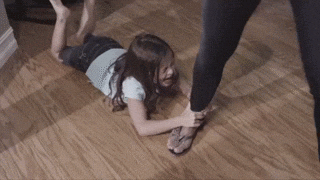New dad says being stay-at-home parent is actually 'easy.' People let him know why he's wrong.
"Update us when you have a kid who can move more."
A baby cries while playing with blocks.
Every now and then, someone will come along on TikTok, state an opinion and then sit back and let the Internet do its thing. Such was the case for Cass Casperson (@Cassandrian) who posted a video where he claims that "stay at home moms are lying."
He writes, "Is this how people get canceled?" He then proceeds to say the following: "What I get to do for work, I can still stay home and pay all the bills. And my wife will have to go to work to make her money. I have a one-year-old daughter. So I'll stay at home and take care of my daughter. And while I'm taking care of my one-year-old daughter, I can cook her three meals a day, change her on time, do naps, play time, arts and crafts time. And still make sure the entire place is clean."
@cassandrian Is this how people get canceled #stayathomemom #sahm #sahd #momtok
Dad says it's esy to be a stay-at-home-parent
He continues, "I can clean the whole apartment while watching her before 12:00 or 1:00. And yes, I know an apartment is different than a house, but I have a 2,300-square-foot apartment. So it's not tiny. But I do know that I can just be ignorant to a lot of people's situations. So can someone please tell me—when does being a stay-at-home mom become hard?"
Well, at least he asked. Now many in the comment section agreed with his sentiment that "staying at home with a child is easy." Some were actually rather unpleasant about it, but everyone has the right to an opinion. The key here though is those who wished him to see another point of view mostly stayed calm and collected while they taught him the lesson he sought.
One commenter shares, "My wife is a SAHM of two kids. One just started school and the other is a feral toddler. You’re on easy mode right now champ. Update us when you have a kid who can move more."
Another person gently explains that having two parents can be easier than one, in terms of hands-on help. "I think the issue has a lot more to do with SAHMs often being the only active parent. While the husband works, he comes home, does no parenting, cooking or helping around the house at all. It is definitely easier when your partner is contributing more than just paying bills."

Postpartum depression and being a stay-at-home mom
But it was this TikToker who brought up a discussion that isn't always easy. "It’s also harder for women who have gone through emotional and hormonal changes as they step into motherhood. Postpartum depression and anxiety do not care if the tasks are easy to do."
In no way were they putting the OP down; they were just bringing up a topic that perhaps he might have missed. Casperson responded, "I hear that."
Postpartum depression is an essential topic to discuss for both new moms and their families. According to an article on PostpartumDepression.org, "Nationally, about 1 in 8 women experience symptoms of postpartum depression after giving birth. However, this rate can be as high as 1 in 5 women in some U.S. states."
Lately, more people with a platform have been open about their struggles. Recently, actress Reese Witherspoon opened up about how awful it was for her. She told Harper’s Bazaar, "In the first six months, I was simultaneously happy and depressed. I just cried all the time, I was up all night, I was exhausted. It was a hormone drop I didn’t expect, which I experienced right after birth and again when I stopped nursing six months later.”
Elizabeth Tenety, co-founder of the parenting platform Motherly, cites a 2018 U.K. study that recently went viral again. According to the study conducted by Aveeno, "31% said staying at home with a child was harder than going to work. While this stat highlights the challenges of full-time caregiving, it’s important to note that the survey focused on new parents rather than all stay-at-home moms."
Tenety notes that being at home full-time with a child carries roadblocks that differ from being in an office. "SAHMs face unique challenges, such as fewer structured breaks, greater social isolation, and a heavier cognitive load at home."
But she also points out that many of these challenges are not just specific to being a child caregiver. "At the same time, many working moms don’t feel they get a break either, as they navigate both career pressures and household responsibilities. Some research suggests that while working parents may experience structured work hours and social interaction, they also report high levels of role overload and work-family conflict."
Of course, to some people's points, it can be stressful to be a stay-at-home parent (mom OR dad). And men can also suffer from the exhaustion and anxiety that comes along with being a new parent. In fact, Upworthy covered a story about a man who experienced severe depression and anxiety after his baby was born, and turned it into a movement where he and other dads would take their babies on walks together.
Everyone responds to stress differently. There are Reddit threads that both support Casperson's views and those who adamantly disagree. Perhaps Casperson is one of the lucky ones who doesn't feel overwhelmed by taking care of an infant. But for every one of him, there are probably ten people who feel differently. It's taking the time to ask the questions (and hopefully registering some of the answers) that matters.

